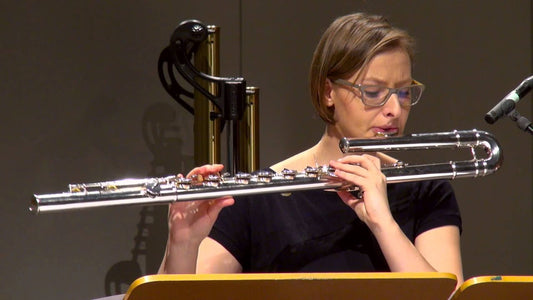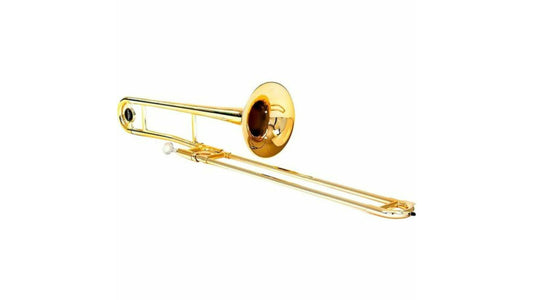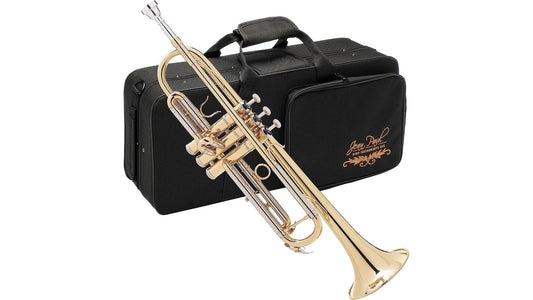Tìm Hiểu Về Kèn Cornet
Kèn cornet có vẻ bề ngoài giống với những chiếc kèn khác, tuy nhiên, với những người chơi kèn đồng thì có thể dễ dàng phân biệt.
Trong màn trình diễn của nhiều tác phẩm cổ điển, không thể thiếu một chiếc kèn cornet. Còn với một ban nhạc kèn đồng hiện đại thì âm thanh của cornet lại giống như tô điểm thêm cho giai điệu trở nên tuyệt vời hơn. Trong các trường học âm nhạc, loại kèn này được dùng như một công cụ giáo dục.
Ngày nay, kèn cornet được làm bằng chất liệu đồng thau, nhưng những chiếc cornet đầu tiên lại được làm từ gỗ. Vào thế kỷ 15 đến 17, kèn cornet được sử dụng rộng rãi. Đến thế kỷ 16, độc tấu cornet trở nên rất phổ biến tại Ý. Và cho đến tận bây giờ, lịch sử âm nhạc vẫn tôn vinh những nhạc sĩ nổi tiếng thời bấy giờ như Giovanni Bassano và Claudio Monteverdi.
Đến thế kỷ 17, violon trở nên thịnh hành hơn và cornet đã dần bị giảm đi vai trò của nó trong âm nhạc. Cornet lần đầu tiên được đưa vào dàn nhạc giao hưởng vào đạt tới thời kỳ đỉnh cao ở thế kỷ 19. Âm thanh của nhạc cụ này thường vang lên trong các bản nhạc của P. Tchaikovsky ("Italian Capriccio"). Phiên bản cập nhật của cornet-a-piston đã trở thành một phần của dàn nhạc giao hưởng và được sử dụng trong các buổi hòa nhạc opera. Người ta cũng tìm thấy một phiên bản khác của cornet trong các ban nhạc kèn đồng.
Nếu bạn đang học kèn cornet, kèn trumpet hoặc bất kỳ nhạc cụ bằng đồng nào thì nhận biết một cây cornet rất quan trọng. Trong bài viết này, chúng ta sẽ điểm tên các bộ phận khác nhau của một chiếc kèn cornet, cùng với mục đích và cách mỗi bộ phận ảnh hưởng đến âm thanh độc đáo của chiếc kèn.
Một chiếc kèn cornet bao gồm có những bộ phận sau:
- Ống ngậm
- Đầu thổi
- Van
- Thanh trượt
- điều chỉnh trượt
- Phím nước
- Loa kèn
Cũng có một vài phần nhỏ hơn, nhưng chúng ta sẽ xem xét chi tiết những phần đó bên dưới.
Ống ngậm
Ống ngậm của kèn cornet không khác gì các nhạc cụ bằng đồng tương tự. Đó là một miếng kim loại nhỏ, hình phễu, nhận không khí từ đầu phát để tạo ra âm thanh. Bạn đặt môi của mình vào ống ngậm, thổi hơi vào, không khí đi vào ống ngậm và qua hệ thống ống phức tạp cho đến khi thoát ra khỏi loa kèn để tạo ra âm thanh.
Hầu hết các ống ngậm đều được làm từ kim loại, điển hình là chất liệu đồng thau mạ vàng hoặc bạc. Tuy nhiên, với những chiếc kèn cornet dành cho trẻ em thì ống ngậm lại được làm từ nhựa để giúp trẻ dễ chơi hơn.
Đầu thổi
Đầu thổi của ống ngậm là một miếng kim loại hình trụ nhỏ gắn ống ngậm vào ống dẫn. Nó thường được làm từ chất liệu đồng thau tương tự như ống ngậm nhưng có thể được mạ bằng chất liệu khác để biểu thị sự tách biệt. Bạn có thể lắp ống ngậm vào đầu thổi mà không dùng quá nhiều lực. Nếu không, cả hai bộ phận có thể bị kẹt theo cách có thể làm hỏng nhạc cụ và bóp nghẹt mọi âm thanh phát ra từ loa kèn.
Đường ống dẫn âm thanh
Ống dẫn là một đoạn kim loại thẳng được gắn vào để nối ống ngậm với thanh trượt điều chỉnh. Ống dẫn được làm bằng chất liệu đồng thau mạ và nó chính là bộ phận ống nối đầu tiên dẫn đến loa kèn.
Móc ngón tay
Xa hơn nữa bên dưới ống dẫn là móc ngón tay, bộ phận này được làm từ một miếng kim loại cong giúp người chơi sử dụng để cầm chiếc kèn cornet một cách thoải mái bằng một tay.
Van
Cornet giống như kèn, có ba van đóng vai trò là bộ phận chính để người chơi thay đổi âm sắc của nhạc cụ. Van đầu tiên nằm gần ống thổi, van thứ hai ở giữa và van thứ ba nằm về gần phía loa kèn. Mỗi van bao gồm một vỏ van và pít-tông van giúp chuyển hướng không khí đến các rãnh trượt khác nhau xung quanh thiết bị.
Sự kết hợp giữa chuyển động của ngón tay làm thay đổi hướng không khí và áp suất không khí cho phép người chơi thay đổi âm sắc và âm lượng.
Vỏ van
Vỏ van là các miếng kim loại hình vòng bảo vệ các pít-tông và giữ chúng ở đúng vị trí. Nếu không có chúng, các pít-tông sẽ bị uốn cong hoặc gãy mỗi khi bạn cố ấn chúng xuống để tạo ra âm thanh cụ thể. Bên trong mỗi vỏ là một miếng đệm cao su nhỏ bịt kín khoảng cách giữa các pít-tông, cho phép người chơi điều khiển áp suất không khí hiệu quả hơn. Điều này giúp tạo ra một lớp đệm kín giúp duy trì áp suất không khí bên trong thiết bị.
Van pít-tông
Van pít tông chính là các miếng kim loại nhỏ có đỉnh phẳng nhô ra khỏi vỏ van. Đây là bộ phận chính giúp người chơi tạo ra các âm sắc khác nhau. Khi bạn xem một người chơi kèn cornet, bạn sẽ nhận thấy các ngón tay của họ di chuyển linh hoạt trên các van pít tông.
Pít-tông phải được kiểm tra và vệ sinh thường xuyên. Nếu không, chúng có thể bị kẹt khi bạn chơi, và làm hỏng các bộ phận lân cạn.
Van trượt
Kèn cornet có các van trượt nhận không khí được chuyển hướng từ các pít-tông. Có một van trượt gần miệng người chơi, một van ở bên phải của nhạc cụ gần thanh trượt điều chỉnh và một van ở đầu xa bên cạnh loa kèn. Người chơi trượt từng van để thực hiện những điều chỉnh nhỏ đối với cao độ của âm thanh phát ra từ loa kèn. Điều này phải được thực hiện với người chơi có kỹ năng tốt vì nó yêu cầu sự phối hợp các chuyển động của ngón tay trên các pít-tông với thời gian chính xác trên từng đường trượt tương ứng.
Thanh trượt điều chỉnh
Thanh trượt điều chỉnh là một trong những bộ phận quan trọng của kèn cornet, chỉ có một thanh trượt duy nhất giúp điều chỉnh giúp quản lý âm sắc. Nó cũng là thanh trượt lớn nhất trên cornet. Mặc dù các đường trượt của van khá nhỏ, nhưng đường trượt điều chỉnh chiếm phần lớn chiều dài của chiếc kèn.
Phím nước
Khi người chơi thổi hơi vào kèn, luồng không khí sẽ thay đổi áp suất và nhiệt độ bên trong nhạc cụ. Kết quả là hơi nước tích tụ bên trong các ống đồng thau, làm giảm chất lượng âm thanh và dẫn đến việc nhạc cụ bị ăn mòn theo thời gian. Cornet có hai phím nước mà người chơi mở để thoát hơi ẩm nhằm ngăn điều này xảy ra. Phím nước đầu tiên nằm ở trên thanh trượt điều chỉnh và thứ hai là trên thanh trượt van thứ ba, cả hai phím nước đều ở phía trước của thiết bị. Chỉ cần nhả từng chốt khi bạn bắt đầu cảm thấy có nước trong âm thanh.
Loa kèn
Loa kèn là bộ phận giúp phát ra âm thanh của nhạc cụ. Loa kèn được cho là bộ phận quan trọng nhất trong kèn cornet. Không có nó, ngay cả người chơi điêu luyện nhất cũng không thể phát ra giai điệu. Loa kèn thường được làm từ chất liệu đồng thau. Tuy nhiên giống như mọi nhạc cụ khác, người chơi có thể thay đổi chất liệu của loa hoặc sửa đổi theo ý của mình.
Ngay cả việc thay đổi một chút hình dạng của loa kèn cũng có thể có tác dụng đáng chú ý. Cornet là một trong những nhạc cụ bằng đồng linh hoạt hơn vì khả năng điều chỉnh của loa. Người chơi có thể thay đổi âm thanh để phù hợp với thể loại, giai điệu và lối chơi mà họ hướng tới.













